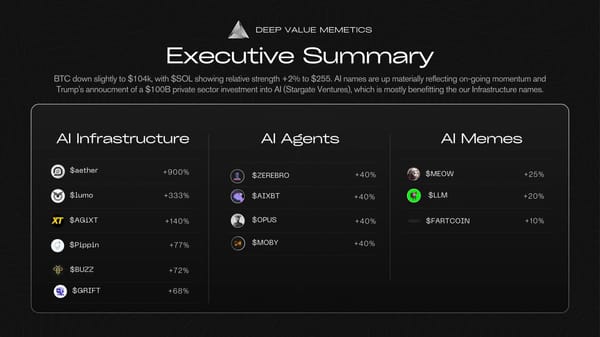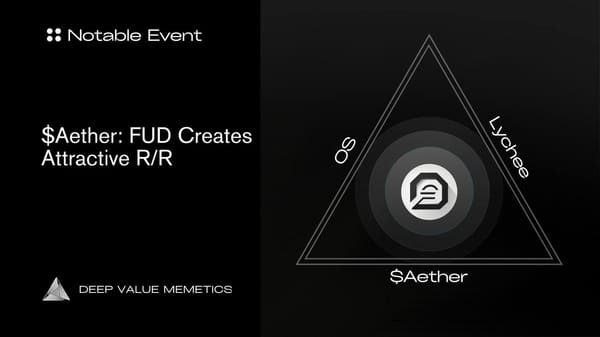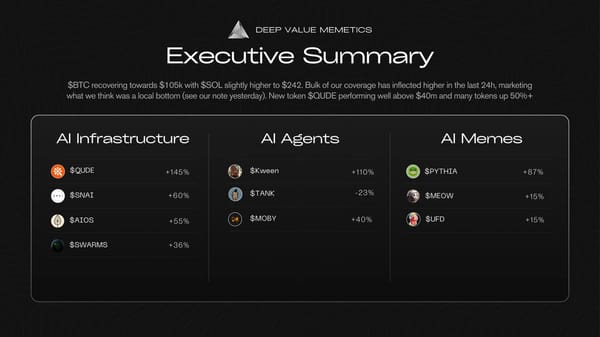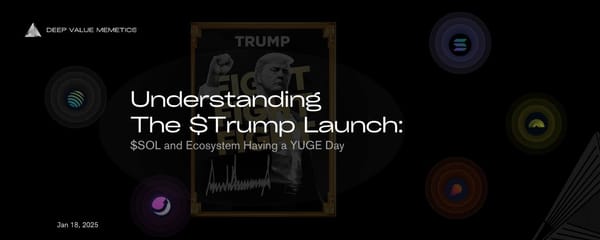A Deep Dive into Frameworks: A Sector we think Could Grow to $20b+
Note: this is a retroactive add to match X publication on (12/27/2024)
In this report, we discuss the landscape for Frameworks within Crypto X AI. We’ll look at the current types (ELIZA, GAME, ARC, ZEREPY) and their technological differences.
Net/Net:
We reviewed and tested the 4 major frameworks through the past week and our conclusions are outlined here (and yes, there’s a Cheat Sheet). We believe $AI16Z will continue to dominate share. The value in Eliza ($ai16z, ~60% market share, $900m Mcap) is its first mover advantage (Lindy Effect) and accelerating use among developers evidenced by 193 contributors, 1.8k forks, and 6000+ stars, leading it to be one of the most popular repositories on Github.
$GAME (~20% market share, $300m Mcap), thus far, is very smooth, and experiencing rapid adoption, as indicated by today’s announcement from $VIRTUAL indicating 200+ projects, 150k daily requests and 200% w/w growth. $GAME will continue to benefit from $VIRTUAL's rise and stands to be one of the biggest winners in their ecosystem. Rig ($ARC, ~15% market share, $160m Mcap) is very compelling and easy to operate given its modular design, and can dominate within the Solana ecosystem (RUST) as a “pure-play”. Zerepy ($ZEREBRO, ~5% market share, $300m Mcap), is a more niche application specific within a cult community, under $ZEREBRO, and its recent partnership with ai16z community likely drives synergies.
We note our market share calculations are a blend of MCap, development record, and breadth of underlying OS end-market. We believe the Framework segment will be the fastest growing through the current cycle, as ~$1.7b in combined MCap could easily grow toward $20b, which could still be conservative vs. peak L1 valuations in 2021 where many achieved $20b+ alone in valuation. While all 3 serve different end-markets (chains/ecosystems), a market cap weighted approach could be most prudent given we view the sector as a rising tide.
Framework Cheatsheet:
In this table we lay out key technologies, components, and strengths for each major framework:
Introduction to the Frameworks
In the intersection of AI x Crypto, several frameworks have emerged to facilitate the development of AI. They include ELIZA by $AI16Z, RIG by $ARC, ZEREPY by $ZEREBRO, and $GAME by $VIRTUAL. Each framework caters to different needs and philosophies in agentic developments, ranging from open-source community projects to performance-focused enterprise solutions.
This note first introduces the frameworks as to what they are, the programming language used, technical architecture, algorithms, and unique features with potential use cases where the framework can be used. Then we compare each framework in terms of usability, scalability, adaptability, and performance. Along with their strengths, and limitations.
ELIZA framework by @ai16zdao via @shawmakesmagic
Eliza is an open-source, multi-agent simulation framework that is designed to create, deploy, and manage autonomous AI agents. Developed in TypeScript as a programming language, it provides a flexible and extensible platform for building intelligent agents that are capable of interacting with humans on multiple platforms while maintaining consistent personalities and knowledge.
This framework’s core capabilities include a multi-agent architecture that supports the deployment and management of multiple unique AI personalities simultaneously, along with a character system for creating diverse agents using the character file framework, and a memory management feature through an advanced Retrieval-Augmented Generation (RAG) system that provides a long-term memory and contextual awareness. Additionally, the Eliza framework offers a smooth platform integration for reliable connection with Discord, X, and other social media platforms.
Eliza is an excellent choice when it comes to communication and media capabilities of AI agents. When it comes to communication, the framework supports integration on Discord with voice channel capabilities, X functionality, Telegram, and direct API access for custom use cases. On the other hand, the framework’s media processing features extend to PDF document reading and analysis, content extraction and summarization from links, audio transcription, video content processing, image analysis, and conversation summarization for handling diverse media inputs and outputs effectively.
The Eliza framework provides a flexible AI model support through local inference with open-source models, cloud-based inference via OpenAI, and default configurations like Nous Hermes Llama 3.1B, with integration support for Claude to handle complex queries. Eliza employs a modular architecture with an extensive action system, custom client support, and a comprehensive API, ensuring both scalability and adaptability across applications.
The use cases for Eliza span multiple domains such as: AI assistants for customer support, community moderation, and personal tasks, as well as social media personas like automated content creators, engagement bots, and brand representatives. It also serves as a knowledge worker for roles such as research assistant, content analyst, and document processor, and supports interactive characters in the form of role-playing bots, educational tutors, and entertainment agents.
The architecture of Eliza revolves around an agent runtime, which integrates seamlessly with its character system (supported by a model provider), memory manager (connected to a database), and action system (linked with platform clients). Unique features of the framework include a plugin system that enables modular functionality extension, support for multi-modal interactions such as voice, text, and media, and compatibility with leading AI models like Llama, GPT-4, and Claude. With its versatile and robust design, Eliza stands out as a powerful tool for developing AI applications across diverse domains.
G.A.M.E Framework by @virtuals_io via @everythingempt0
The Generative Autonomous Multimodal Entities Framework (G.A.M.E), is designed to provide developers with API and SDK access for experimenting with AI agents. This framework offers a structured approach to managing AI agent behavior, decision-making, and learning processes.
The core components are: First, an Agent Prompting Interface as an entry point for developers to integrate GAME into an agent for accessing agentic behavior. The Perception Subsystem initiates sessions by specifying parameters such as session IDs, agent IDs, users, and other relevant details. It synthesizes incoming messages into a format suitable for the Strategic Planning Engine, acting as the sensory input mechanism for AI agents, whether in the form of dialogue or reactions. Central to this is the Dialogue Processing Module for processing messages and responses from the agent and collaborating with the Perception Subsystem to interpret and respond to inputs effectively.The Strategic Planning Engine works in conjunction with the Dialogue Processing Module and the on-chain wallet operator, generates responses and plans. This engine functions at two levels: as a high-level planner to create broad strategies based on context or goals and as a low-level policy to translate these strategies into actionable policies which is further divided into an Action Planner for specifying tasks and a Plan Executor for carrying them out.
A separate but critical component is the World Context, which references the environment, world information, and game states, providing essential context for the agent’s decision-making. Additionally, the Agent Repository for storing long-term attributes such as goals, reflections, experiences, and personalities, that collectively shape the agent’s behavior and decision-making processes.This framework uses short-term working memory and a long-term memory processor. The short-term memory retains relevant information about previous actions, outcomes, and current plans. In contrast, the long-term memory processor extracts key information based on criteria such as importance, recency, and relevance. This memory stores knowledge about the agent’s experiences, reflections, dynamic personality, world context, and working memory to enhance decision-making and provide a foundation for learning.
To add to the layout, the Learning Module consumes data from the Perception Subsystem to generate general knowledge, which is fed back into the system to refine future interactions. Developers can input feedback on actions, game states, and sensory data through the interface to enhance the AI agent’s learning and improve its planning and decision-making capabilities.
The workflow begins with developers interacting through the Agent Prompting Interface. Inputs are processed by the Perception Subsystem and forwarded to the Dialogue Processing Module, which manages interaction logic. The Strategic Planning Engine then formulates and executes plans based on this information, utilizing both high-level strategies and detailed action planning.
Data from the World Context and Agent Repository informs these processes, while the Working Memory tracks immediate tasks. Simultaneously, the Long-Term Memory Processor stores and retrieves knowledge over time. The Learning Module analyzes outcomes and integrates new knowledge into the system, enabling continuous improvement in the agent’s behavior and interactions.
RIG framework by @arcdotfun via @Playgrounds0x
Rig is an open-source, Rust-based framework designed to streamline the development of Large Language Model applications. It provides a unified interface for interacting with multiple LLM providers, such as OpenAI and Anthropic, and supports various vector stores, including MongoDB and Neo4j. The framework’s modular architecture features core components like the Provider Abstraction Layer, Vector Store Integration, and an Agent System to facilitate seamless LLM interactions.
The primary audience for Rig includes developers building AI/ML applications in Rust, while its secondary audience comprises organizations seeking to integrate multiple LLM providers and vector stores into their Rust applications. The repository is organized using a workspace-based structure with multiple crates, enabling scalability and efficient project management. Key features include the Provider Abstraction Layer, which standardizes APIs for completion and embedding across LLM providers with consistent error handling. The Vector Store Integration component offers an abstract interface for multiple backends and supports vector similarity searches. The Agent System simplifies LLM interactions, supporting Retrieval Augmented Generation (RAG) and tool integration. Additionally, the Embeddings Framework provides batch processing capabilities and type-safe embedding operations.
Rig leverages several technical advantages to ensure reliability and performance. Asynchronous operations utilize Rust’s async runtime for handling numerous concurrent requests efficiently. The framework's inherent error-handling mechanisms improve resilience against failures in AI providers or database operations. Type safety prevents errors at compile time, enhancing code maintainability. Efficient serialization and deserialization processes facilitate data handling for formats like JSON, crucial for AI service communication and storage. Detailed logging and instrumentation further aid in debugging and monitoring applications.
The workflow in Rig begins when a client initiates a request, which flows through the Provider Abstraction Layer to interact with the appropriate LLM model. The data is then processed by the core layer, where agents can use tools or access vector stores for context. Responses are generated and refined through complex workflows like RAG, which involves document retrieval and context understanding, before being returned to the client. The system integrates multiple LLM providers and vector stores, allowing adaptability to model availability or performance changes.
Rig’s diverse use cases include question-answering systems that retrieve relevant documents to deliver accurate responses, document search and retrieval for efficient content discovery, and chatbots or virtual assistants that provide context-aware interactions for customer service or education. It also supports content generation, enabling the creation of text and other materials based on learned patterns, making it a versatile tool for developers and organizations alike.
Zerepy framework by @0xzerebro and @blorm_ via @jyu_eth
ZerePy is an open-source, written in Python, framework designed to deploy agents on X, utilizing OpenAI or Anthropic LLMs. Derived from a modularized version of the Zerebro backend, ZerePy allows developers to launch agents with functionality similar to Zerebro’s core features.
While the framework provides a foundation for agent deployment, fine-tuning models is necessary for generating creative outputs. ZerePy simplifies the development and deployment of personalized AI agents, particularly for content creation on social platforms, fostering an ecosystem of AI-driven creativity aimed at artistic and decentralized applications.
The framework, built in Python, emphasizes agent autonomy with a focus on creative output generation, aligning with ELIZA's architectural + Partnership with ELIZA. Its modular design supports memory system integration and facilitates agent deployment on social platforms.
Key features include a command-line interface for agent management, integration with Twitter, support for OpenAI and Anthropic LLMs, and a modular connection system for enhanced functionality.ZerePy’s use cases span social media automation, where users can deploy AI agents to post, reply, like, and retweet, boosting platform engagement. Additionally, it caters to content creation in areas such as music, memes, and NFTs, making it a valuable tool for digital arts and blockchain-based content platforms.
Comparison between the four frameworks
In our view, each framework offers a unique approach to AI development, catering to specific needs and environments which takes the debate away from these frameworks being competitors to closing in on the arguments of each framework offering a unique proposition.
ELIZA stands out for its user-friendly interface, particularly for developers familiar with JavaScript and Node.js environments. Its comprehensive documentation aids in setting up AI agents across various platforms, though its extensive feature set might present a moderate learning curve. Developed in TypeScript, makes Eliza ideal for building agents that are embedded in the web as most of the front end of web infra is built in typescript. The framework excels with its multi-agent architecture, enabling the deployment of diverse AI personalities across platforms such as Discord, X, and Telegram. Its advanced RAG system for memory management make it particularly effective for AI assistants in customer support or social media applications. While it provides flexibility, strong community support, and consistent cross-platform performance, it remains in its early stages and may pose a learning curve for developers.
GAME, designed with game developers in mind, offers low-code or no-code interfaces via an API, making it accessible for less technical users within the gaming sector. However, its specialized focus on game development and blockchain integration could pose a steep learning curve for those without relevant experience. It stands out for procedural content generation and NPC behavior but is limited by its niche focus and the complexity added by blockchain integration.
Rig, due to its use of Rust, might be less user-friendly due to the language's complexity, posing a significant learning challenge, but for those versed in systems programming, it offers intuitive interaction. The programming language itself is known for performance and memory safety as compared to typescript. It comes with strict compile time checks and zero cost abstractions which are necessary to run complex AI algorithms. The language is efficient and its low level control makes it ideal for resource intensive AI applications. This framework offers high-performance solutions with a modular and scalable design, making it ideal for enterprise applications. However, the use of Rust introduces a steep learning curve for developers who are not familiar with the language.
ZerePy, utilizing Python, provides high usability for creative AI tasks, with a lower learning curve for Python developers, especially those with an AI/ML background, and benefits from strong community support due to Zerebro's engagement in the crypto community. Excels in creative AI applications such as NFTs, positioning itself as a strong tool for digital media and the arts. While it thrives in creativity, its scope is relatively narrower compared to other frameworks.
In terms of scalability, ELIZA has made strides with its V2 update, which introduces a unified message bus and a scalable core framework, allowing for efficient management across multiple platforms. However, managing this multi-platform interaction can introduce scalability challenges if not optimized.
GAME excels in real-time processing necessary for gaming, where scalability is managed through efficient algorithms and potentially blockchain's distributed systems, although it might be constrained by the specific game engine or blockchain network's limitations.
Rig Framework leverages Rust's performance for scalability, inherently designed for high-throughput applications, which could be particularly effective for enterprise-level deployments, though this might mean complex setups for achieving true scalability.
Zerepy's scalability is geared towards creative outputs, supported by community contributions, but its focus might limit its application in broader AI contexts, with scalability potentially tested by the diversity of creative tasks rather than user volume.Regarding adaptability, ELIZA leads with its plugin system and cross-platform compatibility, followed by GAME within gaming environments and Rig for handling complex AI tasks. ZerePy demonstrates high adaptability in creative domains but is less suited for broader AI applications.Performance-wise, ELIZA is optimized for quick social media interactions, where fast response times are key, but its performance might vary when dealing with more complex computational tasks.
GAME by Virtual Protocol focuses on high-performance real-time interaction in gaming scenarios, utilizing efficient decision-making processes and possibly blockchain for decentralized AI operations.
Rig Framework, with its Rust foundation, offers excellent performance for high-performance computing tasks, suitable for enterprise applications where computational efficiency is paramount.
Zerepy's performance is tailored towards the creation of creative content, with metrics centered around the efficiency and quality of content generation, potentially less versatile outside of creative domains.Considering the advantages, ELIZA provides flexibility and extensibility, making it highly adaptable through its plugin system and character configuration, beneficial for social AI interactions across platforms.
GAME offers unique real-time interaction capabilities within games, enhanced by blockchain integration for novel AI engagement.
Rig's advantage lies in its performance and scalability for enterprise AI tasks, with a focus on clean, modular code for long-term project health.
Zerepy excels in fostering creativity, leading in AI applications for digital arts, supported by a vibrant community-driven development model.Each framework has its limitations, ELIZA is still in its early stages with potential stability issues and a learning curve for new developers, Game's niche focus might limit broader applications, and blockchain adds complexity, Rig's steep learning curve due to Rust could deter some developers, and Zerepy's narrow focus on creative outputs might restrict its use in other AI fields.
Key Takeaways in framework comparison
Rig ($ARC):
Language: Rust, focusing on safety and performance.
Use Case: Ideal for enterprise-level AI applications due to its focus on efficiency and scalability.Community: Less community-driven, more focused on technical developers.
Eliza ($AI16Z):
Language: TypeScript, emphasizing web3 flexibility and community involvement.
Use Case: Designed for social interactions, DAOs, and trading, with strong emphasis on multi-agent systems.
Community: Highly community-driven, with extensive GitHub engagement.
ZerePy ($ZEREBRO):
Language: Python, making it accessible for a broader AI developer base.
Use Case: Suited for social media automation and simpler AI agent tasks.
Community: Relatively new but poised for growth due to Python's popularity +AI16Z contributor support.
GAME ($VIRTUAL):
Focus: On autonomous, adaptive AI agents that can evolve based on interactions within virtual environments.
Use Case: Best for scenarios where agents need to learn and adapt, like gaming or virtual worlds.
Community: Innovative but still defining its niche amidst competition.Star
History On Github
The illustration above is a reference to the GitHub star history of the frameworks since their launch. It is noted that GitHub stars serve as an indicator of community interest, project popularity, and the perceived value of the project.
ELIZA - Red Line:
Demonstrates a significant and steady increase in stars, starting from a low base in July and experiencing a significant surge in stars starting in late November, reaching 6.1k stars. This indicates a rapid surge in interest that captured the developers attention. The exponential growth suggests that ELIZA has gained substantial traction due to its features, updates, and community engagement. Its popularity far exceeds the others which indicates strong community support and broader applicability or interest in the AI community.
RIG - Blue Line:
Rig is the oldest among four, showing a modest but consistent growth in stars, with a noticeable uptick in the ongoing month. It has reached 1.7k stars but is on an upward trajectory. The steady accumulation of interest is due to continuous development, updates, and a growing user base. This could reflect a niche audience or a framework that is still building its reputation.
ZEREPY - Yellow Line:
ZerePy just launched a few days ago and has grown 181 stars. It is highlighted that ZerePy needs more development to increase its visibility and adoption. The partnership with $AI16Z is likely to attract more contributors to the code base.
GAME - Green Line:
This project has minimal stars, it is noted that this framework can be directly applied on agents within the virtual ecosystem via an API which eliminates the need for visibility on Github. However, this framework has only become available for builders publicly just over a month ago with 200+ projects being built with GAME.
Bull Thesis for the frameworks
Eliza’s version 2 will include integration with the Coinbase agent kit. All projects using Eliza will have future support for native TEE, enabling agents to operate in secure environments. An upcoming feature of Eliza is the Plugin Registry, allowing developers to register and integrate plugins seamlessly. Additionally, Eliza V2 will support automated, anonymous cross-platform messaging. The Tokenomics whitepaper, scheduled for release on January 1, 2025, is anticipated to positively impact the AI16Z token, which underpins the Eliza framework. AI16Z plans to continue enhancing the framework’s utility, leveraging the onboarding of high-quality talent as demonstrated by the efforts of its lead contributor.
The GAME framework offers no-code integration for agents, enabling simultaneous use of GAME and ELIZA within a single project, each serving specific purposes. This approach is expected to attract builders focused on business logic rather than technical complexities. Despite being publicly available for just over 30 days, the framework has seen substantial progress, supported by the team’s efforts to onboard more contributors. It is expected that every project launched on $VIRTUAL will adopt GAME.
Rig, represented by the $ARC token, has significant potential, though its framework’s growth is in the early stages. The handshake program for onboarding projects using Rig has been live for only a few days. However, quality projects paired with ARC are anticipated soon, akin to the Virtual flywheel, but with a focus on Solana. The team is optimistic about a partnership with Solana, positioning ARC to Solana as Virtual is to Base. Notably, the team incentivizes not only new projects launched with Rig but also developers to enhance the Rig framework itself.
Zerepy, a newly launched framework, is gaining traction due to its partnership with $AI16Z (Eliza). The framework has attracted contributors from Eliza, who are actively working to improve it. It enjoys a cult following, driven by fans of $ZEREBRO, and has opened new opportunities for Python developers, who previously lacked representation in the competitive landscape of AI infrastructure. This framework is poised to play a significant role in the creative aspects of AI.




